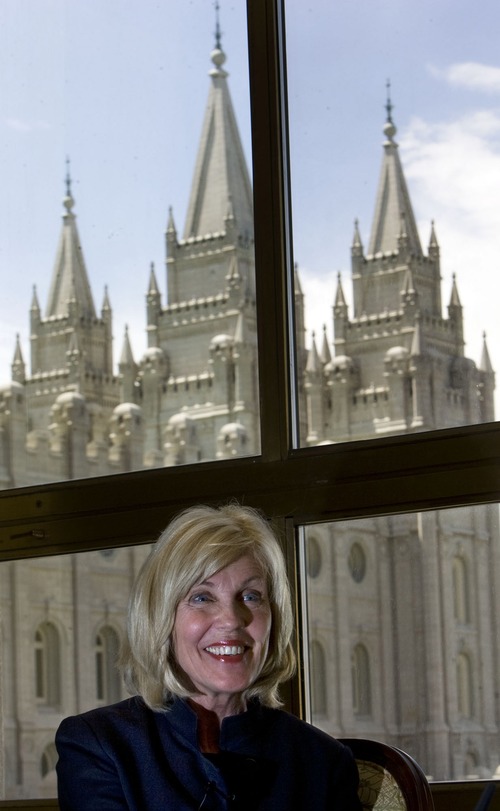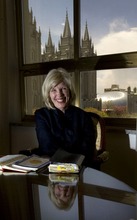This is an archived article that was published on sltrib.com in 2013, and information in the article may be outdated. It is provided only for personal research purposes and may not be reprinted.
Elaine S. Dalton may be one of the most athletic Mormon women leaders the LDS Church has ever had.
As a young college student, Dalton performed around the globe with Brigham Young University's famed folk dancers. When she had small children, the young mother took up running. By now, even as a grandmother, she continues to tackle 26.2-mile marathons — at least 18 and counting.
But preaching to big audiences, overseeing a vast organization and overhauling programs for the next generation of Mormon girls worldwide may have been the race of her life.
If tradition holds, Dalton's run as Young Women's general president could end this weekend at the 183rd Annual General Conference of The Church of Jesus Christ of Latter-day Saints.
She has packed a lot into those five years.
Co-workers say Dalton is "filled with positive energy," "a forward-looking leader" and collegial. She is prayerful, they add, and trusts her spiritual instincts and impressions, while being open to others. She has a personal presence that commands attention and is a magnet for young women.
Dalton, who declined to be interviewed for this story, is said to collect tents, loves hamburgers and takes her daughters on women-only campouts to Yellowstone. She routinely tapped running and hiking metaphors to describe faith journeys.
Stay on the path, Dalton advised; don't lose your way.
Early on, she developed a theme for her presidency: virtue and courage.
"One virtuous, righteous woman can change the world," Dalton told The Salt Lake Tribune in 2008 soon after her appointment as the leader of Mormon girls ages 12 to 17. "It's an exciting time to be a woman. ... An opportunity of a lifetime lies before us."
Dalton spoke regularly about a "return to virtue" and emphasized that one mistake should not keep young women from attending church or seeing themselves as "daughters of God."
Among her most noted accomplishments was modernizing the curriculum for the weekly Young Women's lessons.
Karen Spencer, a home-schooling Mormon mom in Albuquerque met the Young Women's leader last year, when Dalton was doing a training in New Mexico. The two chatted before and after the meeting and Spencer "was impressed with [Dalton's] sincerity."
She seemed "quite willing to have a conversation with anyone in the room," Spencer writes in an email, "not just a quick handshake, as if she were simply a church celebrity, but a genuine conversation."
Dalton explained her hope to "transform the classroom [in LDS settings] to the point that students and teachers were learning and studying together," the mother says. "For example, if anyone had a question the teacher didn't know, everyone would all pull out their Topical Guides [to the Scriptures] and start studying it right then."
Spencer recalls Dalton complaining that LDS Church teaching materials had "shackled" members, both young and old for 35 years. Dalton suggested, according to Spencer, that Young Women were "not learning the doctrine and most of the adults don't know it either."
The young mother was excited about this view of teaching, she says, "because of my own research on teaching generally and in the church."
The new plan rolled out in January 2013 and, to the delight of many feminists, it parallels the lessons taught to young men. Both emphasize the centrality of Jesus Christ in young lives, rather than particular roles.
It shifts the focus for young women from finding a mate or planning for marriage to personal holiness in an LDS temple, says Tresa Edmunds, a Mormon writer in Modesto, Calif., who has been pushing for changes in the program.
"I've always appreciated her emphasis on the temple as part of a young woman's spiritual development," Edmunds writes in an email. "President Dalton emphasized the sacred importance of the covenants made in that ceremony, and the power they have in a woman's life, independent of wherever else her road takes her."
By emphasizing covenant-making in the temple, Dalton told the LDS Church News, the new program prepares young women to serve missions, which they are doing in ever greater numbers after the minimum age dropped from 21 to 19. "A missionary experience helps provide a setting in which she keeps the covenants she has made in the temple as she dedicates her time, talents and personal resources to building the Lord's kingdom."
Unlike many Mormon auxiliary leaders, who mostly address their constituents — whether adult women, girls or children — Dalton spoke directly to LDS fathers in her 2011 General Conference address. The best way to rear a girl, she counseled, is to love her mother.
"You can show your daughter by the way you love and honor your wife that she should never settle for less," she said. "Your example will teach your daughter to value womanhood. You are showing her that she is a daughter of our Heavenly Father, who loves her."
Dalton has occasionally irked feminists, says Emily W. Jensen, who until recently reported on Mormon blogs for the church-owned Deseret News.
They lit up social media, Jensen writes in an email, when Dalton "equated virtue with virginity or told the young women they were responsible for the thoughts of young men, but especially when she said just this year that young women, if they understand their roles and responsibilities, 'will see no need to lobby for rights.' "
Dalton apparently took the criticism in stride. She is well aware of how she is perceived by Mormons online, Jensen notes, and one young women's leader described the general president as "happy, down-to-earth, open and committed."
Her Young Women's marathon may be nearing the finish line, but Dalton's influence, especially her approach to teaching and her help in updating the curriculum, will set the pace for years to come.
Conference set
LDS General Conference is Saturday and Sunday at the Conference Center in downtown Salt Lake City. Saturday's sessions are at 10 a.m. and 2 p.m. with a priesthood meeting for male members at 6 p.m. Sunday's sessions are at 10 a.m. and 2 p.m.





